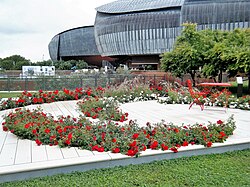This article
may be a rough translation from Italian. It may have been generated, in whole or in part, by a computer or by a translator without dual proficiency.
Please help to enhance the translation. The original article is under "italiano" in the "languages" list.
If you have just labeled this article as needing attention, please add
{{ subst:Translation request |pg=Italian modern and contemporary architecture|language=Italian|comments=}} ~~~~
to the bottom of the WP:PNTCU section on Wikipedia:Pages needing translation into English.(August 2022)



